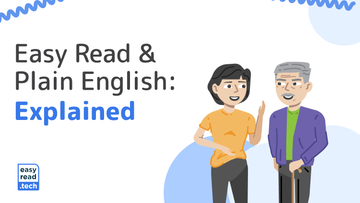Easy Read & Plain English: Explained

Cornerstone Alliance is happy to introduce our new product, easyread.tech! The service was born out of a demand for a high-quality document design service catering to people with cognitive disabilities and people from culturally and linguistically diverse backgrounds. Based in South Australia and powered entirely by local talent, our products, service and technology are wholly crafted with one purpose in mind: better access to information and inclusion for all.
Easyread.tech offers the transformation of documents in both Easy Read and Simple English, but what is that? What do they look like? Do they mean the same thing? Easyread.tech is here to break it down for you, so your organisation can support the mission to make information accessible for all.
EASY READ

Easy Read is a style of publication that combines simple text with layout and imagery. Easy Read is primarily used to support individuals with learning disabilities, CALD/EALD people and people with dyslexia.
Images in Easy Read are used to complement the text and make it easier to comprehend. Easyread.tech offers a gallery of over 2000 original illustrations, all made in South Australia by our team of in-house graphic designers, and all designed to meet current accessibility standards.
PLAIN ENGLISH

Simple English is a style of writing that combines clear, concise expression with an effective structure and good document design. Simple English is about writing clearly so readers can easily absorb and use the information they need from just one reading. It is typically used for everyday written information, like legal documents and instructions. Simple English involves writing to the intended audience, meaning that the level of simplification a document undergoes depends on the target audience.
Simple English is a critical component of multicultural communications and must be undertaken as best practice before any in-language translation, or campaign activity commences. Simple English makes it possible for language translation to be more effective and relevant in delivering important messages to communities. Easyread.tech can assist with the transformation of communication from complex language to Simple English. This would ensure better access to information and inclusion within a diverse landscape of multicultural communities.
What do Easy Read and Simple English have in common?
Easy Read and Simple English are both forms of accessible written information, that allow existing documents to be made more comprehensible for readers.
Both have similar design traits like the use of key headings, white space, easy-to-read font, basic language and grammar, avoidance of jargon and bullet point lists.
How do they differ?
Simple English is a general accessible format that’s level of simplification is determined by the target reader. It is typically used for readers with limited technical understanding but can extend to those who are time-poor and require information quickly, struggle with large volumes of text or cannot rely on in-language translations.
There are fewer stylistic guidelines in Simple English compared to Easy Read; the overall aim is to simplify typically complex documents to allow readers to consume and use the information after one read.
Easy Read documents are produced for people with low literacy levels or learning disabilities, meaning there is typically more white space and less text. There are also more guidelines for Easy Read text, like avoiding abbreviations, contractions, italics or common expressions.
Which style should I use?
Whether you should transform your document into Easy Read or Simple English depends on the audience who will read your document. If your audience includes people with low literacy levels or people with learning/cognitive disabilities, then you should choose an Easy Read transformation. If your audience has good literacy levels and can understand the topic generally, then a Simple English transformation is the best option. Sometimes, a mixture of features from both styles may be the most beneficial for your audience, for example, images may be beneficial to accompany some instructional text in Simple English.
Check out this quick guide to help you decide what style is best for your needs.

Why choose easyread.tech?
When you choose easyread.tech, you will be trusting a diverse team of in-house, South Australian content developers, graphic designers and illustrators who work with people with disabilities and low English literacy levels at the forefront of minds.
Get in touch with easyread.tech today to book a demo, and discuss your next step to accessibility and inclusivity.
References
Centre for Inclusive Design (n.d.), Easy English versus Plain English, Centre for Inclusive Design, viewed 12 January 2023, <https://centreforinclusivedesign.org.au/wp-content/uploads/2020/04/Easy-English-vs-Plain-English_accessible.pdf>.
Government of South Australia 2021, Easy read, Government of South Australia, viewed 12 January 2023, <https://www.accessibility.sa.gov.au/introduction/easy-read>.
Scope, Plain language fact sheet, Scope, viewed 12 January 2023, <https://www.scopeaust.org.au/wp-content/uploads/2014/12/Plain-Language-fact-sheet_Accessible.pdf>.
